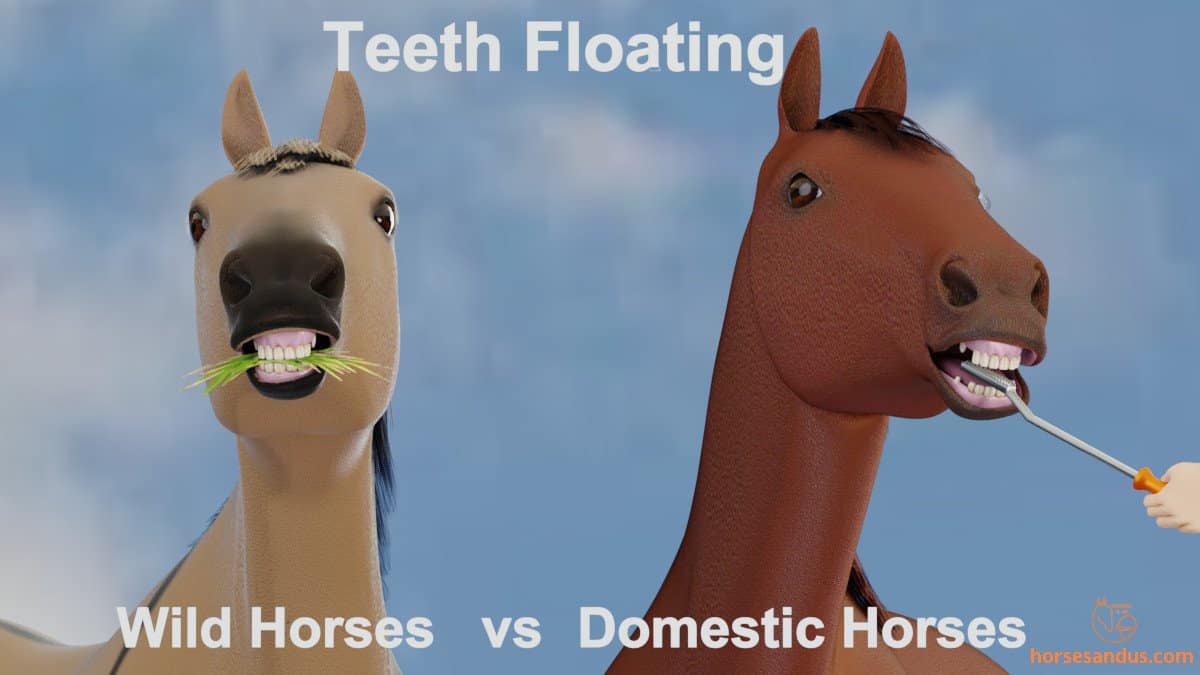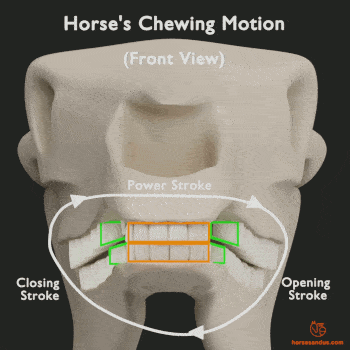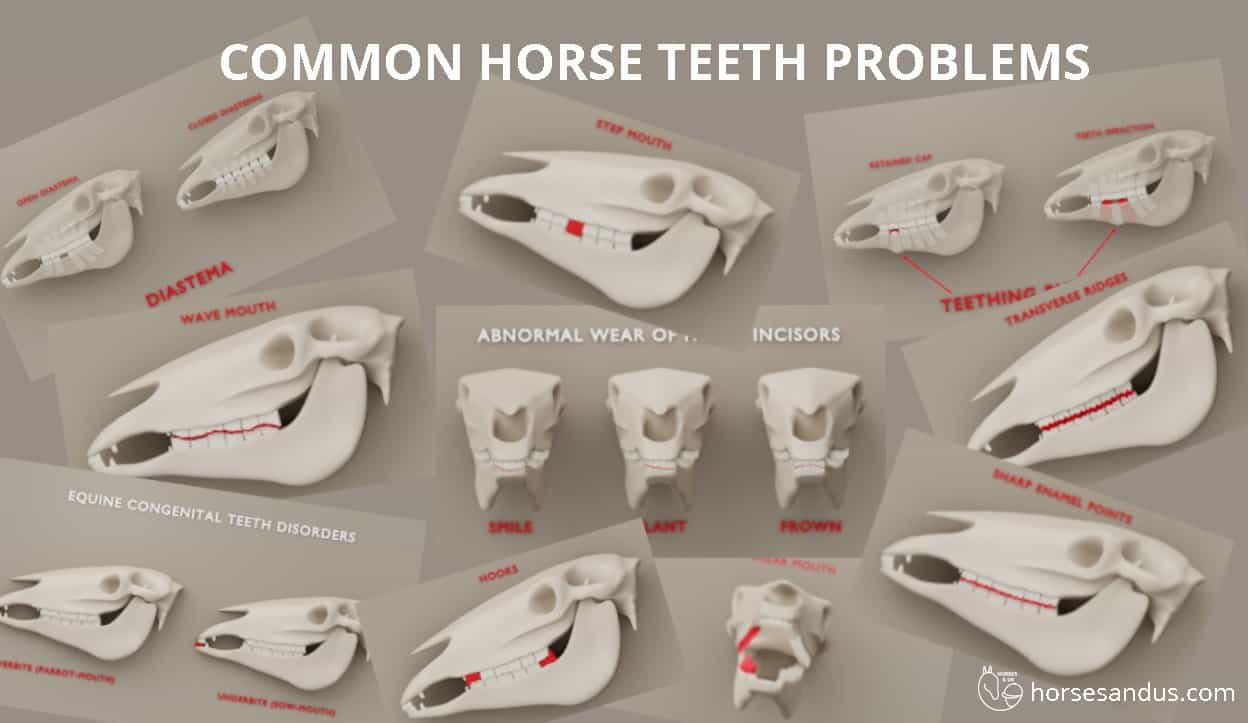The most common dental problem that our horses have is abnormal teeth wear. Which impacts chewing and digestion, leading to loss of weight. It can also cause other serious dental conditions and even death.
This problem is relatively easy to treat in its early stages by floating the sharp overgrowths.
Domestic horses have these dental overgrowths floated by a vet.
But what about wild horses that do not have any dental care?
How do wild horses float their teeth?
Read on to find out.

Do Wild Horses Need Their Teeth Floated?
Wild horses don´t need their teeth floated because they are rasped naturally by chewing fibrous grass all day. The incisors are used to cut the grass. To grind it, the mandible needs to move a long distance laterally so the lower teeth can slide across the entire surface of the upper teeth. This wears teeth evenly without dental overgrowths.

Do Domestic Horses Need Their Teeth Floated?
Domestic horses need to have their teeth regularly floated because they tend to develop abnormal teeth overgrowths, mainly due to their diet. But overgrowths can also be caused by congenital disorders that may exist in a domestic horse but would not allow the horse to survive in the wild.
Abnormal Teeth Wear: Comparison Between Wild And Domestic Horses
“Occlusal wear is a function of three things: the interaction between the two occlusal surfaces (attrition), time spent chewing, and the nature of the material being chewed” – Cuddeford 2004.
It is known that domesticated horses have a significantly higher incidence of abnormal teeth wear than wild or free-grazing horses.
The main reasons are:
- Diet and lifestyle
- Congenital disorders
Abnormal Teeth Wear Associated With Diet and Lifestyle
Horses have hypsodont teeth that continue to grow along their life to compensate for the wear caused by grinding food.
Whenever an area of the tooth surface does not contact the opposing tooth, an overgrowth occurs in that area. To prevent abnormal overgrowth, complete contact on the teeth’ occlusal surface needs to be assured.
Impact Of The Horse’s Diet On Chewing Motion
Studies have shown that the chewing motion depends on the type of food being masticated.
Chewing forage such as grass and hay requires a larger range of motion than chewing processed feed such as pellets or grains.
The image below shows the paths of the chewing motion (in all 3 directions). It compares the chewing of hay and pellets.

This clearly shows that the mandibular range of motion is greater when the horse is chewing forage, such as hay, than when chewing processed feed such as pellets.
Mandibular Has Larger Movement When Eating Forage
When the mandibular has a larger movement, it allows the lower cheek teeth to make occlusal contact across the entire surface of the upper cheek teeth. Consequently, the teeth are evenly worn down, with less occurrence of abnormal overgrowths.
Mandibular Has Shorter Movement When Eating Processed Feed
On the other hand, when the mandibular has a short movement, the upper and lower cheek teeth do not completely slide against each other. Consequently, the areas of the teeth that do not come into contact will develop overgrowths.
Comparison of Dental Abnormalities between Stabled And Free Grazing Horses
Studies made on thoroughbred horses show how diet and grazing time relate to the occurrence of teeth abnormalities.
In these studies, several dental wear abnormalities were compared between stabled and free grazing thoroughbred horses.
The result is shown in the graph below. Dental abnormalities (with the exception of sharp enamel points) have a significantly higher prevalence in stabled thoroughbred horses.

Impact of the Head’s Eating Position On Teeth Wear
Another reason horses develop dental overgrowths is related to the head’s position when horses are eating.
Lowered Head
When horses lower their head, their mandibular jaw slides forward, resulting in a complete alignment of the upper and lower teeth. This allows their teeth to wear down evenly.
So if the horse’s head is lowered when he is eating, his teeth will wear down, evenly because their occlusal surfaces are aligned. This is their natural eating position when they are grazing.
Raised Head
If a horse eats with his head raised, as required by some feeders, the mandible will not slide forward, and therefore the teeth will not be aligned when he is chewing. This can cause abnormal teeth wear such as hooks or excessive transverse ridges.
Source: https://equinewellnessmagazine.com/eating-like-horse/
The image compares head position with teeth alignment.

Conclusion
The table summarizes the diet and lifestyle of wild horses compared to domestic horses.
| Time Spent Chewing | Diet | Head Position | |
|---|---|---|---|
| Wild Horses | Many hours a day (up to 18 h) | Fibrous grass | Lowered |
| Domestic Horses | Few hours a day (2 to 3 hours) | Pellets, grains and hay | Upright |
Domesticated horses’ lifestyle and diet lead to more dental overgrowth than those we find in wild horses because they are not using their teeth properly to wear down evenly.
However we must not forget why we give this diet to our domestic horses.
We require horses to have physical performance levels and good body condition that cannot be achieved without concentrated feed with high energy levels.
Nevertheless, whenever possible, we should provide free access to hay or pastures so horses can have the chance to grind coarse feed all day.
It is also important to place our horses’ food on the ground so they may eat in their natural position with their head lowered and their teeth aligned.
Abnormal Teeth Wear Associated With Congenital Teeth Disorders
When looking at the graph above (fig2), we can see that Sharp Enamel Points were equally found in the stabled and free-ranging thoroughbred horses.
Impact Of Breeding Practices on Congenital Teeth Disorders
It is known that thoroughbreds descend from a small selection of foundation stallions. So it is possible that their mouth´s conformational structures may predispose them to sharp enamel points, regardless of their lifestyle and diet.
This evidence suggests that besides diet and lifestyle, the breeding practices that allow certain conformational structures on domesticated horses may also contribute to dental abnormalities.
There are congenital problems ( parrot mouth, supernumerary teeth, displacements, excessive anisognathism, etc.) that lead to abnormal teeth wear.
In domestic horses, these problems usually can be fixed, and so the horses can survive with regular dental care.
In wild horses, teeth abnormalities resulting from anatomical issues could be fatal. So the natural selection would weed out these problems.
Conclusion
Wild horses tend not to have dental wear abnormalities resulting from congenital problems. Natural selection will gradually eliminate horses with dental issues since they will have more difficulty surviving and producing offspring.
What Is Horse Teeth Floating ?
The correction of a horse´s dental overgrowths is called floating the teeth. This is sometimes also called rasping or filing. Floating a horse’s teeth is done using specialized tools called dental floats to rasp overgrown parts of the teeth, such as sharp enamel points or hooks.
When these sharp edges are removed, the teeth can regain their alignment and eliminate any discomfort caused by the dental overgrowth.
A qualified veterinarian floats the horse’s teeth using dental floats, which are metal files or rasps that come in several shapes and sizes, depending on the intended use and the mouth area to be floated.

These tools should always be disinfected before and after floating the horse’s teeth.
Floats may be manual or motorized. However, special care should be taken with motorized tools because more tooth can be unintentionally removed due to less physical effort required by the operator. This can lead to excessive crown removal and even pulp exposure.
Floating should not be painful because there are no nerve endings on the horse´s teeth surface. However, horses are usually sedated to be more comfortable and safe during the procedure.
A horse with a more severe abnormal wear pattern will require extra rasping and may have a sore jaw after the procedure. It may have difficulty chewing food, so it should eat a softer diet until the mouth returns to a comfortable state.
Why Do Horses Need Their Teeth Floated?
Horses need their teeth floated whenever they have abnormal dental overgrowths (ex: sharp enamel points, hooks) that cause pain, infections or impede them from chewing their food correctly. If their food is not completely masticated, it will not be digested properly and so nutrients cannot be absorbed efficiently, which leads to weight loss.
You may want to check the article on common horse teeth problems to learn all about abnormal dental overgrowths.
How Do You Know When A Horse Needs His Teeth Floated?
If your horse has abnormal teeth wear that require floating he will show the following signs:
- Difficulty chewing and dropping food
- Excessive salivation which can be bloody
- Bad breadth
- Swollen face
- Appetite and weight loss
- Head tossing when riding
- Reluctance to put on the bit
- Large food particles in the manure
Sometimes the dental overgrowths are mild, or the horse finds a way to cope with them, and he may not show evident signs.
Planning Your Horse’s Routine Dental Care
Even if your horse does not show signs of dental problems, you can know if his teeth need floating during routine dental check-ups. These should be planned based on the horse´s age or any other conditions that justify more frequent reviews.
It is useful to know how your horse´s teeth change with age, so you can better identify any signs of dental problems and know when to plan routine dental checkups.
| Age | Dental Checkup | Description |
|---|---|---|
| 2,5 to 5 years | Every 6 months | During this time, deciduous teeth transition to permanent teeth. There may be overgrowths due to retained caps, impacted teeth, displacements. |
| 5 to 20 years | Once a year | The horse’s mouth is more stable and so they may need floating only once a year. |
| More than 20 years | every 6 months | Older horses can quickly develop dental problems because their teeth are more fragile. However, floating should be reduced to the minimum because, at this age, horses have little reserve tooth left to replace what has been worn away. |


